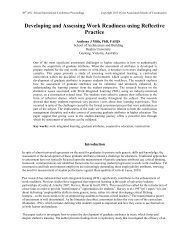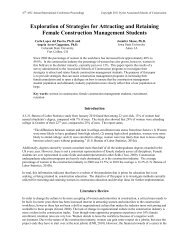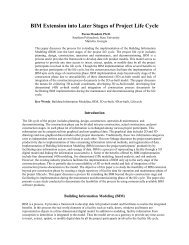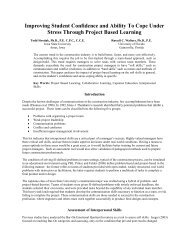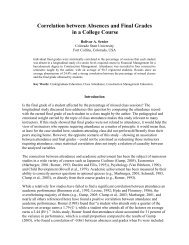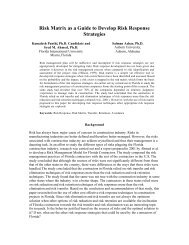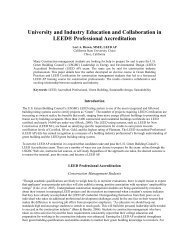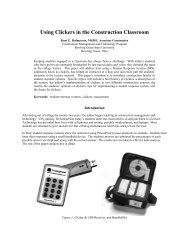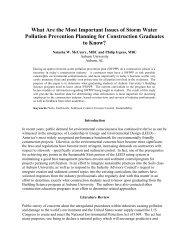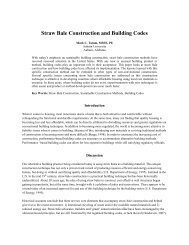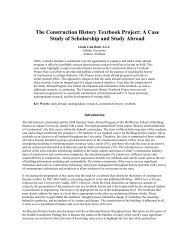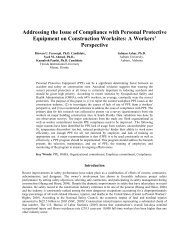Exploring Real Estate Students' Learning Approaches, Reflective ...
Exploring Real Estate Students' Learning Approaches, Reflective ...
Exploring Real Estate Students' Learning Approaches, Reflective ...
You also want an ePaper? Increase the reach of your titles
YUMPU automatically turns print PDFs into web optimized ePapers that Google loves.
48 th ASC Annual International Conference Proceedings Copyright 2012 by the Associated Schools of Construction<strong>Exploring</strong> <strong>Real</strong> <strong>Estate</strong> Students’ <strong>Learning</strong> <strong>Approaches</strong>,<strong>Reflective</strong> Thinking and Academic PerformanceAbdul-Rasheed Amidu, MScBirmingham City University,Birmingham, UKWithin educational research, the student learning approaches and reflective thinking areincreasingly being recognised as cognitive factors in the prediction of student academicperformance in higher education. From this theoretical perspective this study reports the results ofa study involving real estate students using the Revised Study Process Questionnaire (R-SPQ-2F),developed recently by Biggs et al. (2001) and the <strong>Reflective</strong> Thinking Questionnaire (RTQ)developed by Kember et al. (2000) to investigate their learning approaches – deep and surface -,the four stages of reflective thinking and academic performance in one of the core real estatemodules (property valuation).Key Words: <strong>Reflective</strong> thinking, learning approaches, descriptive analysis, real estateIntroductionOne of the topical issues that have attracted widespread attention in educational research is the teaching and learningprocesses. Of particular interest is a range of student’s academic learning issues, including concerns about theefficacy of learning approaches and the levels of reflective thinking demonstrate by students in their academiclearning. Within the body of academic literature that have addressed these issues, there seem to be a generalagreement that educators need to be proactive in helping students to adopt deep approach to learning and alsodevelop critical thinking skills in the learning process to learn. This is against the background of previous empiricalresearch evidence (see for example Drew and Watkins, 1998; Leung and Kember, 2003; Mezirow, 1991; 1998;Phan, 2006; Watkins, 2001; Wong and Watkins, 1998) suggesting significant relationships between learningapproaches, stages of reflective thinking and academic performance.Notwithstanding the above, It has been argued by (Biggs et al., 2001) that students turn to adjust their styles oflearning based on the demand of the course that they are enrolled in. Also there is ample evidence in literature tosuggest, for example, that subject disciplines influence student learning approaches and reflective thinking(Skogsberg and Clump, 2003; Smith and Miller, 2005). This study therefore expands the line of previous researchby investigating real estate students’ learning approaches and stages of reflective thinking and the way bothcognitive factors are related to each other and students’ academic performance in property valuation. The choice ofproperty valuation module is borne out of the fact that the author teaches on the real estate programme and isparticularly responsible for co-ordinating the delivery and assessment of the module. The module introduces moresophisticated approaches and applications of valuation theory to a range of commercial situations. It is taught toLevel 5 <strong>Real</strong> <strong>Estate</strong> students to enable them develop the underpinning knowledge and skills required to select themost appropriate means of valuation for different purposes and to question the validity of the traditional methods ofvaluation. The module is assessed by means of coursework (based on a practical valuation assignment whichrequires students to inspect a property, carry out measurement and market research, undertake valuation and producea valuation report in response to a client’s instruction) and examination (based on scenario style questionsinstructing students to carry out valuation/investment analysis of fictitious property).Broadly, valuation education is viewed as real estate problem solving concerned with value formation, an issueconfronting the property discipline globally. The difficulty in property valuation is compounded by the
48 th ASC Annual International Conference Proceedings Copyright 2012 by the Associated Schools of Constructionheterogeneous nature of property and lack of transaction information in most market. Because of the nature of theproblem, human judgment is particularly important to the property valuation assignment. Furthermore, valuationeducation has an implicit connection to issues of human decision-making behavior and decision making. However,it is not uncommon to find, for instance, valuation educators emphasising only the mathematical aspects of thesubject in their teaching and assessments (Amidu, 2011). It would, therefore, be interesting to test the theoreticalconclusions that students who adopt deeper and reflective approach to learning are more likely to achieve highacademic performance within real estate subject domain. The specific research questions addressed in this studyare:‣ What learning strategy and level of reflective thinking do real estate students adopt in their academiclearning‣ What are the direct effects of real estate students’ learning approaches and reflective thinking practice onacademic performance in property valuation‣ How does real estate students’ learning approaches influence their reflective thinking practice in theiracademic learningThe structure of the paper is as follows: The next section will provide an overview of learning approach andreflective thinking practice. The third section will describe the research methods adopted in this study. Section fourwill provide a descriptive analysis of the findings of this survey. The paper will conclude with some tentativepractical implication for real estate education.Student’s <strong>Learning</strong> Approach and <strong>Reflective</strong> Thinking PracticeAn approach to learning, according to Ramsden (1987), can be defined as the manner in which a student organises alearning activity. In other words, it is the way of describing the response of student to a learning task and that may,of course, vary from time to time (Biggs, 1993; Rowe & Harris, 2000). The notion of student learning approaches iscredited to the experimental work of Marton and Saljo (1976). In this pioneering research, students’ approaches toreading academic articles were studied. Using confirmatory factor analysis, the research identified two majorcategories of approaches to learning: deep and surface. In the case of surface approach, the student engages inleaning the text itself with the intention of reproducing it without any further analysis. In contrast, students whoadopt deep approach to learning direct their attention towards understanding the authors’ meaning and linking it totheir previous knowledge and personal experience (Murphy and Tyler, 2005). In summary, the discourse in deepapproach is towards comprehension as opposed to reproduction conception of learning demonstrated in surfaceapproachFollowing this theoretical perspective, additional learning approach – strategic approach – have also been suggestedby Entwistle and Richardson (1983) in their research work carried out at the University of Lancaster. The strategicapproach is based on achieving motivation and involves strategies (such as systematic use of previous paper inrevision, good organisation, effective note taking, awareness of marking scheme and criteria) that lead to highmarks. It is important to emphasise that out of these three types of learning approaches, the deep approach is viewedas most desirable in higher education.<strong>Reflective</strong> thinking, on the other hand, is defined as “active, persistent, and careful consideration of any belief orsupposed form of knowledge in the light of the grounds that support it and the conclusion to which it tends” (Dewey,1993, p9). According to Dewey, reflective thinking practice emphasises the consequences of ideas and suggestsfuture physical action to confront and solve a variety of personal and professional obstacles (Norton, 1997 as cited in
48 th ASC Annual International Conference Proceedings Copyright 2012 by the Associated Schools of ConstructionPhan, 2006). Within the teaching and learning processes, the practice cultivates meaningful learning and helpsstudents to develop specific skills and expertise in their subject domain.<strong>Reflective</strong> thinking may be categorised into four construct in their order of importance (Kember et al., 2000). Thesecomprise: habitual action, understanding, reflection and critical reflection. Habitual action is performing a givenactivity automatically with little consciousness or thought. Understanding is the application of prior knowledgewithout reflecting on the link to other personal and practical situations. Reflection involves the critique of anypremises underlying the context of our problem solving. Finally, critical reflection is a higher level of reflectionwhich involves validating beliefs in our prior learning. Within higher education, there is an increasing demand forstudents to reflect on their subject-based studies and personal development of skills required to enter professionaland managerial life.Drawing on these theoretical perspectives, a number of educational researches have explored the causal effects ofstudents’ learning approaches and reflective thinking practice on academic performance. With respect to thelearning approach, evidence from research focusing on students in higher education (see for example Caro, 2005;Drew and Watkins, 1998; Watkins et al., 1991; Wong and Watkins, 1998; Phan, 2006) suggests that deep andstrategic approaches to learning relate positively to academic performance while the surface approach relatesnegatively. On reflective thinking practice, the empirical evidence appears to be limited to the works of Phan (2007;2008; 2009). The conclusion emerging from these studies is that habitual action and understanding are negativelycorrelated with academic performance whereas reflection and critical reflection appear to be positively related toacademic performance.Research MethodologyParticipantsParticipants in this survey were second and third year <strong>Real</strong> <strong>Estate</strong> Undergraduates at a UK based University. Thestudents were given the choice whether they wish to participate or not. Those who choose to participate werefurther instructed to write down their student’s number in order to collect performance marks in property valuation.As the author of this paper is also the valuation module tutors, participating students were assured of anonymity.Measurement InstrumentsEach participant was given a questionnaire that contains statements of study behaviour and reflective thinkingpractice. Study behaviour – student approaches to learning – was measured with the Revised Study ProcessQuestionnaire (R-SPQ-2F) recently developed by Biggs et al. (2001) and used in several empirical studies (see forexample Biggs et al. 2001; Fox et al., 2001; Leung and Kember, 2003; Phan, 2006). The R-SPQ-2F consists of 20items description (Appendix A) of two learning approaches – deep and surface. Each approach has two subscales,motive and strategy, comprising 5 items on a 5 – point Likert scale rating ranging from 1 (always true of me) to 5(only rarely true of me). <strong>Reflective</strong> thinking practice was measure by RTQ developed by Kember et al (2001). TheRTQ consists of 16 items description (Appendix B) of the four types of reflection thinking described in Kember et al(2001). Participating students were instructed to rate each item on a five-point scale ranging from (1) definitelyagree to (5) definitely disagree. Academic performance in property valuation was measured by students’ overallmark at the end of semester 1 year 2. The mark consists of 50% coursework (valuation project) and 50% finalexamination.Data AnalysisPrevious studies investigating both cognitive factors (students learning approaches and reflective thinking) havegenerally employed descriptive and structural equation modelling methods of analysis. The SEM, according to
48 th ASC Annual International Conference Proceedings Copyright 2012 by the Associated Schools of ConstructionBollen (1989); Byrne (1998) and Kline (2005) is a more powerful statistical tool capable of exploring both directand indirect causal relationships between latent variables and also takes into account both structural andmeasurement errors. However, due to small sample size (40), only descriptive analysis was employed in testing theresearch questions postulated for this study.Summary of Findings and ConclusionsThe evaluation of the questionnaire involves two levels of analysis, the internal reliability of for the R-SPQ-2F andRTQ and the relationships between the variables under investigation. The internal reliability was assessed usingCronbach’s alpha. Trait et al (1988) proposed that an alpha of 0.50 is acceptable for a measure producing scoresthat demonstrate satisfactory internal consistency reliability. Details of Cronbach’s alpha alongside the means andstandard deviations are presented in Table 1. The alpha values ranged from 0.52 to 0.76 for the subscales of RTQand 0.55 to 0.81 for the subscales of R-SPQ-2F. These values seem to be acceptable when compared with thebenchmark proposed by Trait et al. (1998) and the previous findings of Biggs et al. (2001) and Kember et al (2000).Table 1Mean, standard deviation and Cronbach alpha for scales and subscales of the RTQ and R-SPQ-2FMean SD Alpha Kember et al(2000)Biggs et al(20001)RTQHabitual action 11.58 3.27 0.52 0.62Understanding 16.20 3.42 0.76 0.76Reflection 15.00 2.80 0.63 0.63Critical reflection 13.33 3.55 0.66 0.68SPQDeep approach 30.55 5.81 0.75 0.73Deep motive 15.18 3.30 0.55 0.62Deep strategy 16.13 3.19 0.63 0.63Surface approach 24.75 6.81 0.81 0.64Surface motive 10.88 3.84 0.73 0.72Surface strategy 13.88 3.80 0.70 0.57A cross correlation analysis was undertaken between the scales of learning approach and reflective thinking practice,their subscales and students overall grade in property valuation to search for any relationship. The correlationalmatrix data are as reported in Table 2.As evidenced in Table 2, surface approach subscale correlation is significant and moderately negatively related withthe overall property valuation module mark. This is expected and, indeed, corroborates the findings of previousresearch such as those of Caro (2005), Drew and Watkins (1998), Watkins et al. (1991), Wong and Watkins (1998)
48 th ASC Annual International Conference Proceedings Copyright 2012 by the Associated Schools of Constructionand Phan (2006). Consistent with the studies of Phan (2007; 2008; 2009), a significant negative association was alsoobserved between habitual action subscale and academic performance in property valuation. Surprisingly andcontrary to what was found in the work of Phan (2007; 2008; 2009) a negative association was observed betweenreflection, critical reflection and academic performance, although this is statistically insignificant. The results inTable 2 also indicate that deep approach to learning correlation coefficient was significant and averagely positivelyrelated with reflection and critical reflection while surface approach appears to be significantly negatively correlatedwith understanding, reflection and critical reflection subscales. Again, these findings appear consistent with priorresearch and the general notion that students who are reflective turn to adopt a deeper approach to learning.Table 2Correlational matrix between variablesHA U R CR DA SA PerHA 1.000U -0.148 1.000R 0.148 0.626** 1.000CR 0.166 0.260*** 0.502** 1.000DA -0.071 0.171 0.545** 0.406** 1.000SA 0.062 -0.515** -0.624** -0.256*** -0.419** 1.000Per -0.387* 0.037 -0.024 -0.090 0.013 -0.271*** 1.000Note: HA = habitual action, U = understanding, R = reflection, CR = critical reflection, DA = deep approach, SA =surface approach, Per. = academic performance. Note: * p ‹ 0.05 level, ** p ‹ 0.01 level, *** p ‹ 0.1 levelThe negative correlation between surface approach and overall valuation module mark is expected and appears tohave confirmed research findings that students who are surface learners tend to have lower academic performance.The same conclusion can be adduced for habitual action on reflective thinking practice subscale; although studentswho adopt reflective approach are not necessarily rewarded in terms of marks according to the findings of this study.It is possible that this arises from the disciplinary context of real estate in which this study was conducted. Inconducting property valuation, there are many technical procedures and, as students become more confident, theymay well carry out these as a matter of routine habit. This, perhaps, might have influenced the students’ responsesto the reflection scale. It may also be concluded that even though the RTQ operates as expected in terms of internalconsistency, its use in real estate discipline is questionable. Finally, it is possible that some “noise” factors are atplay and have not been taken into consideration in this study. This may include, for example, the assessmentcriteria, which may not be focused on the development of reflective capacity of students.To conclude, the findings of this research turn to suggest that, to a great extent, both R-SPQ-2F and RTQ operate asexpected in terms of internal consistency and reliability. This is encouraging. However, the fact that this study isbased on a relatively small sample (40) as compared to previous studies conducted in this line of research means thatthe conclusions above should be read with caution. In future, the researcher intends to expand the number ofparticipants in the survey to other students in the built environment to meet the requirement of a more sophisticatedstatistical analysis such as linear structural equation.
48 th ASC Annual International Conference Proceedings Copyright 2012 by the Associated Schools of ConstructionReferencesAmidu, A. (2011); Research in Valuation Decision Making Processes: Educational Insights and Perspectives”,Journal of <strong>Real</strong> <strong>Estate</strong> Practice and Education, 14 (1), 19-33Biggs, J. (1993); What do Inventories of Students’ <strong>Learning</strong> Processes <strong>Real</strong>ly Measure? A Theoretical Review andClarification, British Journal of Educational Psychology, 63, 3-19Biggs, J., Kember, D. & Leung, D.Y.P. (2001); The Revised Two-Factor Study Process Questionnaire: R-SPQ-2F,British Journal of Educational Psychology, 63 (3), 133-149Cano, F. (2005); Epistemological Beliefs and <strong>Approaches</strong> to <strong>Learning</strong>: Their Change Through Secondary Schooland their Influence on Academic Performance, British Journal of Educational PsychologyDewey, J. (1993); How Do We Think: A Restatement of the Relation of <strong>Reflective</strong> Thinking to the EducativeProcess, Boston: D.C. HealthDrew, P. & Watkins, D. (1998); Affective Variables, <strong>Learning</strong> <strong>Approaches</strong> and Academic Achievement; A CausalModelling Investigation with Honk Kong Tertiary Students, British Journal of Educational Psychology, 68, 173-188Kember, D., Leung, D., Jones, A., Loke, A.Y., McKay, J., Sinclair, K., Tse, H., Webb, C., Wong, F.K.Y., Wong, M.& Yeung, E. (2000); Development of a Questionnaire to Measure the Level of <strong>Reflective</strong> Thinking, Assessment andEvaluation in Higher Education, 25, 381-389Leung, D.Y.P. & Kember, D. (2003); The Relationship between <strong>Approaches</strong> to <strong>Learning</strong> and Reflection uponPractice, Educational Psychology, 23 (1), 61-71Marton, F. & Saljo, R. (1976); On Qualitative Differences in the <strong>Learning</strong> II, Outcome as a Function of theLearner’s Conception of the Task, British Journal of Educational Psychology, 46, 115-127Mezirow, J. (1991); Transformative Dimensions of Adult <strong>Learning</strong>, San Francisco, CA: Jossey-BassMezirow, J. (1998); On Critical Reflection, Adult Education Quarterly, 48, 185-198.Murphy, S.M. & Taylor, S. (2005); The Relationship between <strong>Learning</strong> <strong>Approaches</strong> to Part-Time Study ofManagement Courses and Transfer of <strong>Learning</strong> to the Workplace, Educational Psychology, 25 (6), 455-469Phan, H.P. (2006); Examination of Student <strong>Learning</strong> <strong>Approaches</strong>, <strong>Reflective</strong> Thinking, and Epistemological Beliefs:A Latent Variables Approach, Journal of Research in Educational Psychology, 10 (4 (3)), 577-610Phan, H.P. (2007); Examination of Student <strong>Learning</strong> <strong>Approaches</strong>, <strong>Reflective</strong> Thinking, and Self-Efficacy Belief atthe University of the South Pacific: A Path Analysis, Educational Psychology, 27 (6), 789-806Phan, H.P. (2009); <strong>Exploring</strong> Students’ <strong>Reflective</strong> Thinking Practice, Deep Processing Strategies, Effort andAchievement Goal Orientation, Educational Psychology, 29 (3), 297-313Ramsden, P. (1987); Improving Teaching and <strong>Learning</strong> in Higher Education: The Case for a Relational Perspective,Studies in Higher Education, 14 (2), 157-158Rowe, J.W.K. & Harris, B. (2000); A Theory Based Modification of the Engineering Tutorial, European Journal ofEngineering Education, 25 (3), 235-242Skogsberg, K. & Clump, M. (2003); Do Psychology and Biology Majors Differ in their Study Processes and<strong>Learning</strong> Styles? College Student Journal, 37 (1), 27-33Smith, S.N. & Miller, R.J. (2005); <strong>Learning</strong> <strong>Approaches</strong>: Examination Type, Discipline of Study and Gender,Educational Psychology, 25 (1), 43-53
48 th ASC Annual International Conference Proceedings Copyright 2012 by the Associated Schools of ConstructionWatkin, D. (2001); Correlates of <strong>Approaches</strong> to <strong>Learning</strong>: A Cross-Cultural Met – Analysis. In R. Stemberg & L.F.Zhang (Eds), Perspectives on Thinking, <strong>Learning</strong> and Cognitive Styles, (pp.165-195), Mahwah, NJ: LawrenceErlbaumWatkin, D., Regmi, M. & Astiila, E. (1991); The Asian Learner as a Rote Learner Stereotype: Myth or <strong>Real</strong>ity,Educational Psycholog, 11, 21-34Wong, N. & Watkins, D. (1998); A Longitudinal Study of Psychosocial Environment and <strong>Learning</strong> <strong>Approaches</strong> inthe Hong Kong Classroom, Journal of Educational Research, 91, 247-254AppendixAppendix ARevised Study Process QuestionnairePlease fill in the appropriate circle alongside the statements about your attitude towards your studies. The lettersalongside each statement stand for the following response.A – this item is never or only rarely true of meB – this item is sometimes true of meC – this item is true of me about half the timeD – this item is frequently true of meE – this item is always or almost always true of mePlease choose the one most appropriate response to each statement. Do not spend a long time on each item; yourfirst reaction is probably the best one. Please answer each item
48 th ASC Annual International Conference Proceedings Copyright 2012 by the Associated Schools of Construction1 I find that at times studying gives me a feeling of deep personal satisfaction A B C D E2I find that I have to do enough work on a topic so that I can form my ownconclusions before I am satisfiedA B C D E3 My aim is to pass the course while doing as little work as possible A B C D E4 I only study seriously what’s given out in class or in the course outlines A B C D E5 I feel that virtually any topic can be highly interesting once I get into it A B C D E6I find most new topics interesting and often spend extra time trying to obtain moreinformation about themA B C D E7 I do not find my course very interesting so I keep my work to the minimum A B C D E89I learn some things by rote, going over and over them until I know them by hearteven if I do not understand themI find that studying academic topics can at times be as exciting as a good novel ormovieA B C D EA B C D E10 I test myself on important topics until I understand them completely A B C D E1112I find I can get by in most assessment by memorising key sections rather thantrying to understand themI generally restrict my study to what is specifically set as I think it is unnecessaryto do anything extraA B C D EA B C D E13 I work hard at my studies because I find the material interesting A B C D E141516I spend a lot of my free time finding out more about interesting topics which havebeen discussed in different classesI find it is not helpful to study topics in depth. It confuses and wastes time, whenall you need is a passing acquaintances with topicsI believe that lecturers shouldn’t expect students to spend significant amounts oftime studying materials everyone knows won’t be examinedA B C D EA B C D EA B C D E17 I come to most classes with questions in mind that I want answering A B C D E18I make a point of looking at most of the suggested readings that go with thelecturesA B C D E19 I see no point in learning materials which is not likely to be in the examination A B C D E20I find the best way to pass examinations is to try to remember answers to likelyquestionsA B C D E
48 th ASC Annual International Conference Proceedings Copyright 2012 by the Associated Schools of ConstructionAppendix B<strong>Reflective</strong> Thinking QuestionnairePlease circle the appropriate letter to indicate the level of your agreement with statements about your actions andthinking in this course so far. The letters alongside each statement stand for the following response.A – definitely agreeB – agree only with reservationC – only to be used if a definite answer is not possibleD – disagree with reservationE – definitely disagree1When I am working on some activities, I can do them without thinking about whatI am doingA B C D E2 This course requires us to understand concepts taught by the lecturer A B C D E3 I sometimes question the way others do something and try to think of a better way A B C D E4 As a result of this course I have changed the way I look at myself A B C D E5In this course we do things so many times that I started to do them withoutthinking about themA B C D E6 To pass this course you need to understand the content A B C D E7I like to think over what I have been doing and consider alternative ways of doingitA B C D E8 The course has challenged some of my firmly held ideas A B C D E910As long as I can remember handout materials for examinations, I do not have tothink too muchI need to understand the material taught by the lecturer in order to performpractical tasksA B C D EA B C D E11 I often reflect on my actions to see whether I could have improved on what I did A B C D E12 As a result of this course I have changed my normal way of doing things A B C D E13 If I follow what the lecturer says, I do not have to think too much on this course A B C D E1415In this course you have to continually think about the material you are beingtaughtI often re-appraise my experience so I can learn from it and improve my nextperformanceA B C D EA B C D E16 During this course I discovered faults in what I had previously believed to be right A B C D E
48 th ASC Annual International Conference Proceedings Copyright 2012 by the Associated Schools of Construction



